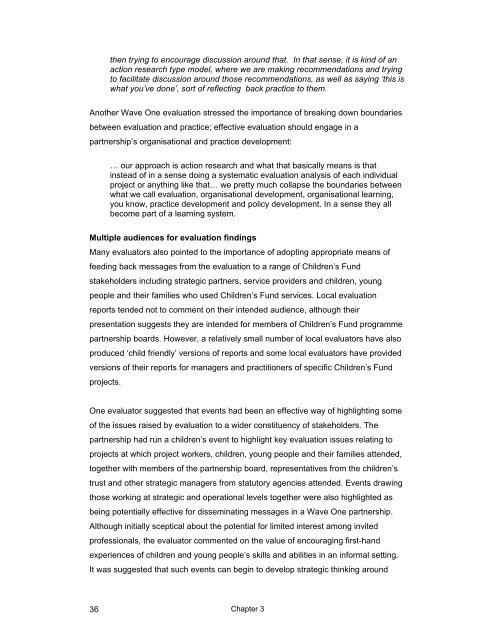Local Evaluation of Children's Services Learning from the Children's ...
Local Evaluation of Children's Services Learning from the Children's ...
Local Evaluation of Children's Services Learning from the Children's ...
- No tags were found...
Create successful ePaper yourself
Turn your PDF publications into a flip-book with our unique Google optimized e-Paper software.
<strong>the</strong>n trying to encourage discussion around that. In that sense, it is kind <strong>of</strong> anaction research type model, where we are making recommendations and tryingto facilitate discussion around those recommendations, as well as saying ‘this iswhat you’ve done’, sort <strong>of</strong> reflecting back practice to <strong>the</strong>m.Ano<strong>the</strong>r Wave One evaluation stressed <strong>the</strong> importance <strong>of</strong> breaking down boundariesbetween evaluation and practice; effective evaluation should engage in apartnership’s organisational and practice development:… our approach is action research and what that basically means is thatinstead <strong>of</strong> in a sense doing a systematic evaluation analysis <strong>of</strong> each individualproject or anything like that… we pretty much collapse <strong>the</strong> boundaries betweenwhat we call evaluation, organisational development, organisational learning,you know, practice development and policy development. In a sense <strong>the</strong>y allbecome part <strong>of</strong> a learning system.Multiple audiences for evaluation findingsMany evaluators also pointed to <strong>the</strong> importance <strong>of</strong> adopting appropriate means <strong>of</strong>feeding back messages <strong>from</strong> <strong>the</strong> evaluation to a range <strong>of</strong> Children’s Fundstakeholders including strategic partners, service providers and children, youngpeople and <strong>the</strong>ir families who used Children’s Fund services. <strong>Local</strong> evaluationreports tended not to comment on <strong>the</strong>ir intended audience, although <strong>the</strong>irpresentation suggests <strong>the</strong>y are intended for members <strong>of</strong> Children’s Fund programmepartnership boards. However, a relatively small number <strong>of</strong> local evaluators have alsoproduced ‘child friendly’ versions <strong>of</strong> reports and some local evaluators have providedversions <strong>of</strong> <strong>the</strong>ir reports for managers and practitioners <strong>of</strong> specific Children’s Fundprojects.One evaluator suggested that events had been an effective way <strong>of</strong> highlighting some<strong>of</strong> <strong>the</strong> issues raised by evaluation to a wider constituency <strong>of</strong> stakeholders. Thepartnership had run a children’s event to highlight key evaluation issues relating toprojects at which project workers, children, young people and <strong>the</strong>ir families attended,toge<strong>the</strong>r with members <strong>of</strong> <strong>the</strong> partnership board, representatives <strong>from</strong> <strong>the</strong> children’strust and o<strong>the</strong>r strategic managers <strong>from</strong> statutory agencies attended. Events drawingthose working at strategic and operational levels toge<strong>the</strong>r were also highlighted asbeing potentially effective for disseminating messages in a Wave One partnership.Although initially sceptical about <strong>the</strong> potential for limited interest among invitedpr<strong>of</strong>essionals, <strong>the</strong> evaluator commented on <strong>the</strong> value <strong>of</strong> encouraging first-handexperiences <strong>of</strong> children and young people’s skills and abilities in an informal setting.It was suggested that such events can begin to develop strategic thinking around36Chapter 3
















